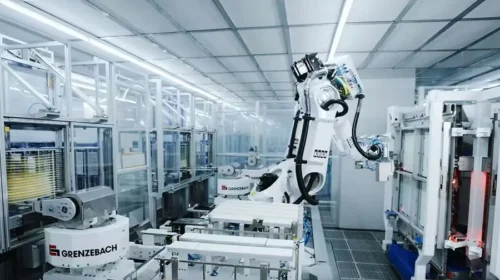A McDonald’s Valuation Downsize, and New Medical Plan Additions

The value of McDonald’s China operation has plunged by more than half in the last year. And 91 companies got their drugs added to China’s national health plan
By Doug Young & Rene Vanguestaine
McDonald’s China operation has seen a stunning drop in value over the past year, leaving investors and analysts scratching their heads. In 2023, McDonald’s repurchased a 28% stake in its China business from its U.S. private equity partner, Carlyle, at a price that valued the whole operation at $6 billion. Fast forward to today, when Reuters reports that the other major stakeholder, China’s own Citic Group, has set up a fund with some other investors that will hold its controlling stake in the operation. But a transaction involving some asset shuffling in this process has valued the entire McDonald’s China operation at just $2.2 billion – less than half the value just a year ago.
There are a couple of forces at play here. First and foremost, the broader economic picture in China has shifted dramatically. It’s clear that this valuation drop reflects more than just a change in McDonald’s operations — it’s indicative of how investor sentiment about the Chinese consumer market has evolved. A year ago, optimism was high; many expected consumer spending to surge post-Covid. But as it turned out, the recovery has been underwhelming. The Chinese consumer, long seen as a growth engine, remains cautious, with deflationary pressures and stagnation continuing to dampen confidence.
For McDonald’s, this drop in consumer enthusiasm has translated into lower expectations for future growth. And while some may argue that the asset-shuffling maneuver by Citic Group has contributed to the fall in valuation, it’s hard to ignore the fact that McDonald’s is now looking at a much more cautious China market.
This shift in expectations is a recurring theme across the fast-food sector in China. However, McDonald’s biggest rival in the market, Yum China, which owns the KFC brand, has demonstrated more stability, thanks in large part to its aggressive expansion strategy. Even so, Yum China has not been immune to the broader challenges, with same-store sales dipping by 3% in the latest quarter — highlighting the continued caution among Chinese consumers. For investors, it’s becoming increasingly clear that the near-term outlook for consumer-facing businesses in China remains subdued.
Fast Food: A Safe Bet During Economic Struggles?
With China’s economic growth faltering, many investors are wondering whether lower-cost food chains like McDonald’s and KFC are more resilient than their higher-end counterparts. After all, when the economy slows, consumers often trade down, seeking cheaper alternatives.
The answer isn’t as straightforward as one might think. While fast food may seem more recession-proof compared to luxury dining, it still faces significant pressure. The real “recession-proof” restaurants, in many cases, are those that cater to the wealthier segments of society. High-end restaurants — though fewer in number in China — often maintain strong customer bases, as their patrons are less affected by broader economic downturns. For middle-market restaurants, including fast food, things are tougher. As consumer sentiment weakens, people shift towards more affordable options, including grocery stores and budget eateries.
This trend is particularly relevant in the Chinese market, where the consumer base remains price-sensitive. The shift to more economical choices is evident across industries, from dining to coffee consumption. Even with its lower price point, fast food is not entirely “recession-proof”; it only has a little better chance of weathering the storm than those restaurants squeezed in between very high end and the low end.
The National Health Plan and Pharmaceutical Opportunities
The latest revision to China’s National Reimbursement Drug List (NRDL), published last week, added 91 new drugs. They come from a wide range of companies, from domestic names like Everest Medicines, whose kidney drug was included, to AstraZeneca, which got one of its breast cancer drugs included.
A comparable system to China’s NRDL in the U.S. is Medicare’s formulary, which determines the list of drugs covered by the government’s health insurance program. Both systems aim to manage healthcare costs by establishing which medications are eligible for reimbursement, creating a framework for drug companies to navigate in order to access a broad base of patients. Like the NRDL, drugs included in Medicare’s formulary see significantly higher usage, but the reimbursement often comes at a lower price point, posing challenges for pharmaceutical companies in terms of profit margins.
Getting on the NRDL opens the door to huge potential sales — especially in a market as large as China. But it also comes with some hefty trade-offs. One of the most well-known caveats is that the Chinese government demands steep discounts from pharmaceutical companies, sometimes as high as 80% off the normal price, although recent discounts have become less drastic. While this can be frustrating for companies, the sheer size of the Chinese market means they can still recoup some of these losses through volume.
From an investor’s perspective, the question is whether the revenue growth from these sales compensates for the lower margins, as the lower prices in China can be a dealbreaker. However, for companies with blockbuster drugs targeting common ailments like blood pressure or kidney disease, the sheer volume of potential customers can make China too big of a market to ignore.
As these pharmaceutical companies navigate the delicate balance between revenue and profit margins, the long-term prospects of having a drug included on the NRDL are hard to resist. While margins might be lower than what companies would see in the West, the numbers in China are so large that they can still lead to substantial returns.
About China Inc
China Inc by Bamboo Works discusses the latest developments on Chinese companies listed in Hong Kong and the United States to drive informed decision-making for investors and others interested in this dynamic group of companies.
Subscribe to China Inc on your favorite app:








